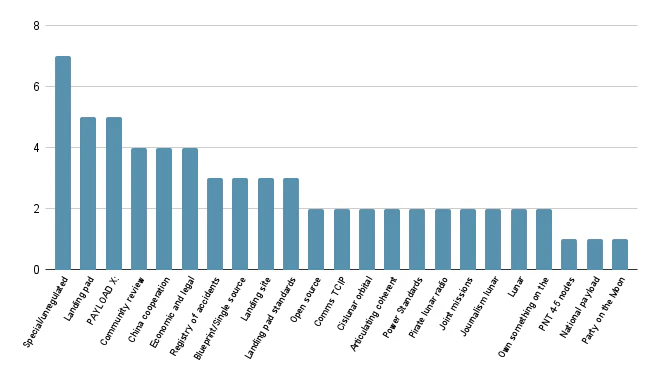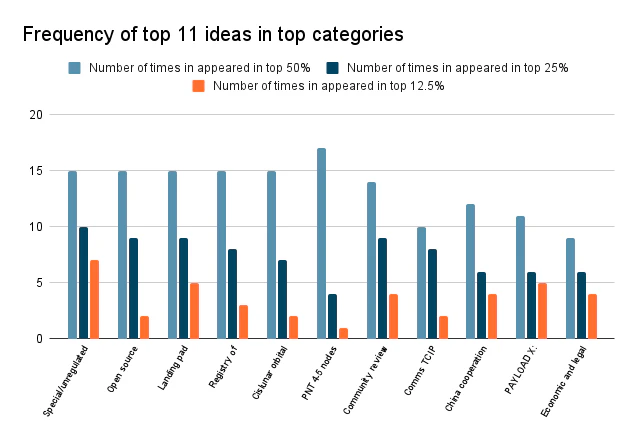Collaboratively developing ideas into hunches was a major milestone in Open Lunar’s development. Previously, our process for developing ideas around our fellowships was run by a small group of highly engaged experts. This worked well, but we wanted to see what would happen if we really opened up our approach to collecting ideas and collaborating on their evaluation. We are called “Open” Lunar, after all! In this piece we want to share two things:
Explain the final step in our hunch selection.
Share the complete list of ideas which were evaluated by our community in 2023.
We talked about this evolution in the context of the genesis of Open Lunar in an earlier blog post: “Deciding Where We Invest”. We were excited to share the results, published in this post: “Our Upcoming Areas of Research”. Now, we want to explain and explore the nuts and bolts of how we ran our process. We believe that this level of transparency will help to reveal new proposals and ideas in the future, help prevent knowledge loss by sharing what we’ve already considered, and help you and our community understand what is and is not meeting our impact criteria.
Where the ideas came from
For 2023, we collected new ideas from our network and considered ideas we’ve had on the docket for some time. Going forward, we will establish a routine process whereby anyone can submit an idea for us to consider. We’ll then work with our community to distil those ideas into a short list that our network scores using the below system or an improvement on it. We’ll continue to include past ideas that weren’t selected, as these may change over time as the community’s priorities change.
Step 1: Scoring
We invited over 25 experts to delve into and prioritize a list of 33 ideas for possible projects Open Lunar could take on in 2024. This handpicked group of participants from across our community were provided with an Excel sheet to systematically rank the concepts against our nine-fold impact criteria (this means that in total the participants ranked against 297 criteria!). They did this by scoring every idea against each of the 9 criteria as 0, 1, 3 or 9, where ‘0’ is abstaining or don’t know, and 9 is highly aligned. The maximum score was 81.
Following their individual assessments, we convened for rich discussion and community learning, thereby facilitating deep dives into each idea and its potential. This meeting worked to share diverse perspectives on the ideas and then allow the evaluators to recalibrate their rankings with new understandings.
Step 2: Analysis
Everyone involved submitted their scoring, and our staff worked to synthesize and make sense of it all. The data was heavily analyzed, and it was clear that there was a shortlist. It was exciting to see how aligned our stakeholders are, and how much shared consensus exists towards projects which would be suitable for Open Lunar to pursue.
First, Open Lunar looked at the highest-scoring projects and obtained the below results:
Figure 1: Frequency at which ideas were given the highest scores (71-81)
Next, we looked at the frequency of projects appearing in the top-scoring groups, segmented as scores of 41, 61 and 71 to 81. This helped us to understand what projects scored highest overall across all criteria, meaning they had the broadest as well as strongest support. The chart below shows the top 11 ideas that scored strongly across all distributions.
For example, “Special/Unregulated Economic or Protection Zones” was the highest frequency project in the top group, scoring between 71-81 seven times. This indicates that 30% of all responses scored this idea a 9 for 8/9 criteria.
Ideas that frequently scored above 41, but did not show up as frequently in the top group 71-81 can be considered a “middle” group. These ideas are not the favorites but they do have broad interest.
Step 3: Results
These are the top 10 ideas that our analysis surfaced:
Special/Unregulated Zones/Economic Zones/Protection Zones - Legal exploration of the establishment of zones for permitted activities. E.g. free craters, safe-to-fail biology experiments, science-only zones, and nuclear test site analogues.
Landing Pad Infrastructure Development Strategy - Develop a business model concept for how landing pad infrastructure could be developed and invested in cooperatively and with good governance/stewardship.
Community Review Board (ICANN meets FAA for the Moon) - Establish a payload review process for lunar payloads, open to wide community participation, assigning a public rating according to a community-developed set of criteria and values.
Open Source Network Timekeeping Protocol + PNT 4-5 Nodes - Create an international and interdisciplinary WG to develop a network timekeeping protocol for the cislunar environment that could be used by all actors to interoperate regardless of hardware or nationality.
PNT: Develop a concrete design for a small constellation to prototype an open standard for positioning, navigation and timing services in the cislunar environment"
Registry of Accidents and Issues - Explore what it would look like to build a registry of accidents and issues, for all lunar missions, and enroll mission leads in the use, data gathering and sharing required to make it a success.
Cislunar Orbital Cartography - create maps of important lunar orbits to enhance shared understanding of how they might be used and where there might be conflict or contention.
Comms TCP/IP - developing and simulating an open protocol stack for Lunar TCP/IP (where end-to-end connectivity is available), such that actors can easily interoperate with each other.
China Cooperation Advancement - identifying payload or policy demonstration partnerships that could be pursued with China.
Payload X: Roadmap to Lunar Settlement (ten years on from the Low-Cost Lunar workshop, research toward what has changed) - Review the roadmap to settlement, conduct a gap/blockage analysis of key enabling factors based on 2023 technology availability, propose a payload which would unlock the ecosystem's advancement.
Step 4: Internal Review
The Open Lunar team then had to take these top ten results and sense-check them. Our staff considered practical factors toward a final decision - Which are getting scored highest on the criteria, and are feasible for our organization to take on at this time? This internal review included many additional considerations which we do not expect our community members to weigh in on, such as:
Cost Implications
Clear Definition of Success
Potential Scope / Impact
Short to medium-term milestones
Diversity Across Portfolio
Bravery/Boldness
In the future, we’d like to explore how we can engage the community at this stage as well. Perhaps, engaging our Affiliate Group to have an open discussion about these ideas.
The following ideas didn’t pass this stage of the process:
Conclusions
We loved undertaking this process. Not only was it a great opportunity to engage the talented network in Open Lunar’s orbit to surface the ideas worth working on, but it was itself an experiment in Open Lunar Governance (pun intended)!
We’re already talking about what we can do next year to improve our process. Some questions we have, include:
How to improve the top of our funnel? How can we bring new ideas in and run them through a simple primary filter to avoid having ideas that aren’t really practical or relevant?
Taking 30 ideas, and ranking them across 9 criteria using 4 scores was a lot of work! It took our evaluators a long time. How can we achieve the same fidelity with less effort.
Did we have the right scoring framework? Is it sound to search for the ideas with the broadest and highest scores? Or should we try another method?
Getting from 10 ideas down to 7 Hunch fellowships was an internal process this year. We wonder how we can engage our network, perhaps a smaller group, to take us from 10 to 5 for next year.
Finally, what can we do with the ideas that don’t make the cut? Many are still excellent. We’ve thought about a bounty board of live ideas where we share their rankings and update them over time.
If you have ideas or thoughts, please contact us. We’d love to hear from you! There are three ways you can get engaged and support this work, thanks for joining us in creating a sustainable Lunar future:
The Complete Long List of 2023 Open Lunar Ideas
In this section, we will be listing the ideas which were taken into consideration by the community. We know it’s long, and in future, we don’t always expect the list to be made up of 30+ options, however, we are grateful for the creativity and outside-the-box thinking which is represented here. These ideas are extremely diverse both in terms of topic and in terms of level of development, so please take it as contextual and inspirational reference information for future thinking on what we could achieve together or add to future ideas-to-hunches processes.
Cislunar orbital cartography: Create maps of important lunar orbits to enhance shared understanding of how they might be used and where there might be conflict or contention.
PNT 4-5 nodes: Develop a concrete design for a small constellation to prototype an open standard for positioning, navigation and timing services in the cislunar environment
Fly a clock: Develop a plan to fly and test a single commodity off the shelf clock as a payload on an existing mission, to prototype the process of offering a timing service for other missions.
Party on the Moon: A campaign to help people envision a future on the Moon by planning a minimum viable party there, and figuring out what needs to be true for the party to happen.
Lunar sundial: A totally passive (requires zero power or comms) timekeeping utility cum art installation to enable first order synchronization of overhead spacecraft, celebrating the value of coordination.
Pirate lunar radio: Taking amateur radio "moon bounce" practices to a new level, install a low powered radio beacon on the lunar surface open to any spacecraft for relaying information back to earth. motivating the development of timesharing protocols and involving amateur ham operators around the world to pick up the signals and contribute to lunar transparency and coordination.
Community review board (ICANN meets FAA for the Moon): Establish a "guerilla" payload review process for lunar payloads, open to wide community participation, assigning a public rating according to a community-developed set of criteria and values.
Landing site competition analysis: A deconfliction assessment and mapping sites of shared interest
Joint missions: A legal exploration of how to approach joint missions under ITAR
National payload review and licensing: Articulating when and how payloads (as opposed to mission) should be treated as their own activity worthy of government oversight and approval.
Economic and legal models for lunar infrastructure: Blueprints for lunar settlement economics; what's the business model of a co-investment into landing pads? Whats the long term user/customer model for the pre-requisite infrastructure of settlement?
Mammalian reproduction: Determine whether intergenerational space living is possible for mammals
Power Standards: Developing a baseline understanding of the level of standardization that exists in power provision and identify opportunities for voluntary standards development and areas where a lack of transparency prevents such development.
Specific tool standards (Drills): Honeybee drill, standards of use/deployment for drilling on the moon
China cooperation advancement: Identifying payload or policy demonstration partnerships that could be pursued with china
Special/unregulated zones/economic zones/protection zones: Legal exploration of the establishment of zones for permitted activities E.g. free craters, safe-to-fail biology experiments, science only zones, nuclear test site analogy
Journalism lunar bellingcat: Lunar journalism network/information sharing, research, lead-generating efforts
Lunar constitution/manifesto - overarching agreement to align all subsidiarity: Meta policies/principles, luna carta, long term - avoid tissue rejection, guides all other Open Lunar activities
PAYLOAD X: Roadmap to lunar settlement (ten years on from the Low-Cost Lunar workshop, research toward what has changed): Review the roadmap to settlement, conduct a gap/blockage analysis of key enabling factors based on 2023 technology availability, and propose a payload which would unlock the ecosystem's advancement.
Open source timekeeping protocol: Create an international and interdisciplinary WG to develop a network timekeeping protocol for the cislunar environment that could be used by all actors to interoperate regardless of hardware or nationality.
Comms TCIP: Developing and simulating an open protocol stack for Lunar TCP/IP (where end-to-end connectivity is available), such that actors can easily interoperate with each other.
Flight Software / Landing Software: What is the gap in flight software that’s causing lunar landings to fail repeatedly
Articulating coherent dust management protocols: Articulate possible norms of behaviour or mission protocols which could support cooperative dust mitigation
Vehicle-level dust mitigations: Investigate lander and rover hardware improvements which might add dust mitigation value. What are the "mudflaps" of dust?
Landing pad infrastructure development strategy: Develop a business model concept for how landing pad infrastructure could be developed and invested in cooperatively and with good governance/stewardship
Landing pad standards: Hyperstition standards for future development of landing pads, across multiple scenarios of how landing pads might be implemented (e.g. "Main landing sites vs occasional use)
Emergency aid protocols (human flights?): Build on the global consensus for mutual aid through articulating specific protocols for lunar-specific emergency aid protocols
Blueprint/Single source of truth re: standards and interfaces across many types of lunar tech: Build a public wiki-style website or document which gathers and makes transparent all the standards currently being used for lunar technology, and begin socializing it so others use it.
Own something on the Moon: Buy or receive a donation of natural or man-made objects on the lunar surface (e.g. end of end-of-life rover/lander)
Radiation measurement experiments (has flow-on effects across all of lunar development): Conduct an initial assessment of how we could aid in supporting radiation experiments/clarifying basic scientific understanding of rad issues on lunar surface as it impacts other work.
“Backup life and knowledge on the Moon” // partner with Arch Mission, offer a radio service blasting human knowledge to the universe: Scope what's required to place a "back up of Earth" capsule on the Moon, including multiple types of human knowledge retention such as written/audio/radio signal, DNA banks etc.
Registry of accidents and issues (build a shared understanding of problems): Explore what it would look like to build a registry of accidents and issues, for all lunar missions, and enrol mission leads in the use, data gathering and sharing required to make it a success.
Kamikaze Landing Trials: Crowdsource a mission to send 100 tiny landers on one ride and have them attempt to land one after the other, modifying the software on each one until you can stick the landing, and then demonstrating that it can be done reliably with the remaining landers. you commit to open-sourcing the resulting software as a library anyone can use.


